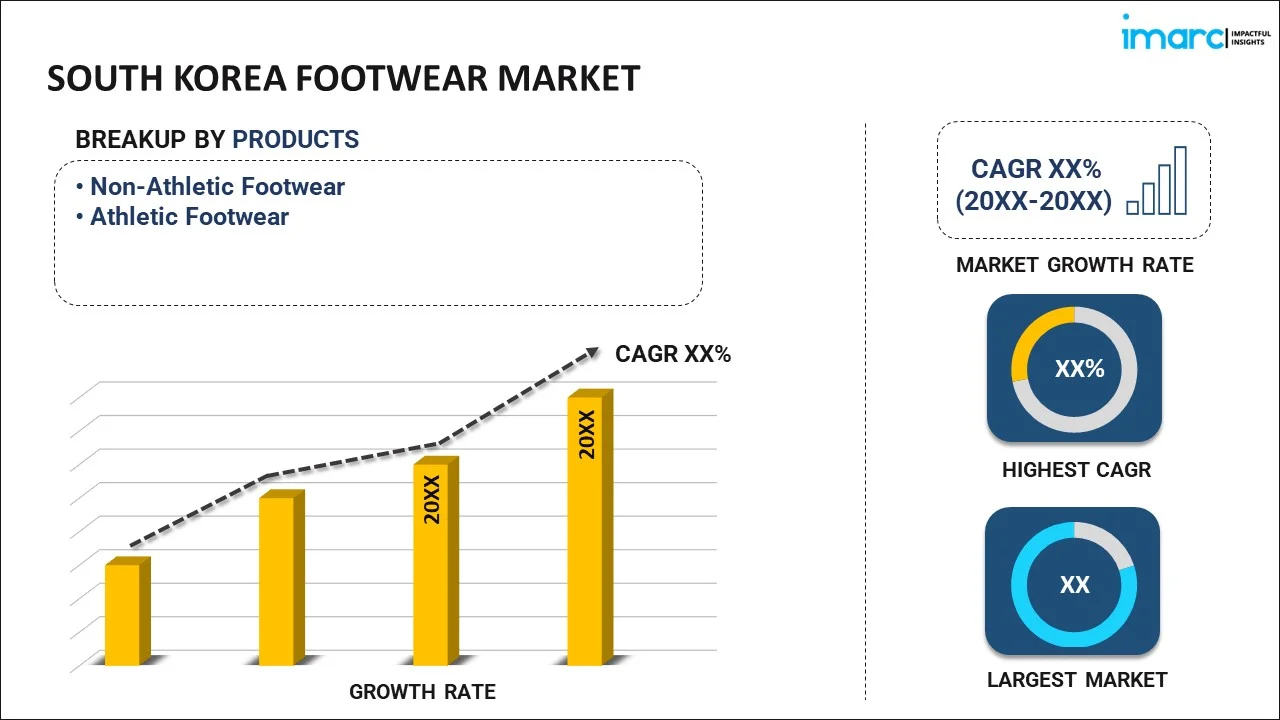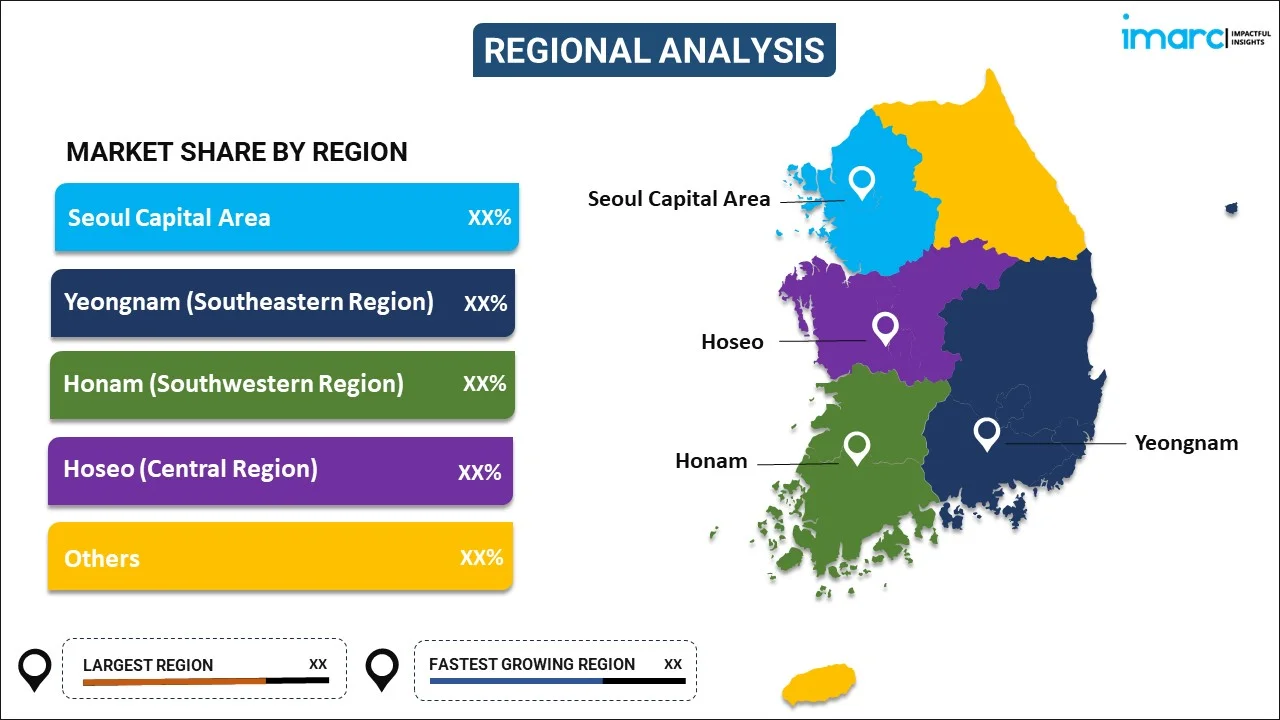
South Korea Footwear Market Report by Product (Non-Athletic Footwear, Athletic Footwear), Material (Rubber, Leather, Plastic, Fabric, and Others), Distribution Channel (Footwear Specialists, Supermarkets and Hypermarkets, Departmental Stores, Clothing Stores, Online Sales, and Others), Pricing (Premium, Mass), End User (Men, Women, Kids), and Region 2025-2033
Market Overview:
South Korea footwear market size reached USD 4,800.8 Million in 2024. Looking forward, IMARC Group expects the market to reach USD 7,059.6 Million by 2033, exhibiting a growth rate (CAGR) of 4.38% during 2025-2033. The growing demand for comfortable and versatile footwear options, rising adoption of augmented reality (AR) to offer immersive shopping experiences, and increasing technological innovations in manufacturing processes represent some of the key factors driving the market.
|
Report Attribute
|
Key Statistics
|
|---|---|
|
Base Year
|
2024 |
|
Forecast Years
|
2025-2033
|
|
Historical Years
|
2019-2024
|
| Market Size in 2024 | USD 4,800.8 Million |
| Market Forecast in 2033 | USD 7,059.6 Million |
| Market Growth Rate (2025-2033) | 4.38% |
Footwear refers to any form of covering designed to protect and provide comfort to the feet while performing various activities. It encompasses a wide range of products, such as shoes, boots, sandals, and sneakers, each tailored for specific purposes. It is produced through several stages, starting from design and material selection to cutting, assembling, and finishing. It can be made from multiple materials, including leather, rubber, textiles, and synthetic compounds, each contributing different qualities like durability, flexibility, and comfort. It shields the feet from various hazards like sharp objects, extreme temperatures, and moisture, reducing the risk of injuries and discomfort. It reduces strain on the lower body and enhances performance in sports and physical activities. It plays a vital role in fashion and personal expression, often reflecting individual style and cultural trends.
South Korea Footwear Market Trends:
At present, the rising demand for comfortable and versatile footwear options that can be worn both during physical activities and as a fashion statement represents one of the crucial factors impelling the growth of the market in South Korea. Additionally, increasing technological innovations in manufacturing processes are enabling the production of more durable, comfortable, and environment-friendly footwear. The use of 3D printing and automated machinery is also streaming production, allowing for quicker turnaround times and customization options. Besides this, the growing investments by brands in enhancing the in-store experience through innovative store designs and interactive displays are positively influencing the market. Moreover, the rising collaborations between footwear brands and other industries, such as sports brands or fashion designers, are resulting in limited-edition collections that generate excitement among buyers. In addition, the increasing adoption of online-to-offline (O2O) strategies by retailers, where customers can explore footwear options online and then visit physical stores to try them on, is contributing to the market growth in the country. This approach combines the convenience of online shopping with the tactile experience of trying on shoes in-store. Furthermore, the growing trend of footwear rental services, particularly for formal events and special occasions, is offering a favorable market outlook. This trend aligns with the need for sustainable consumption and a preference for access over ownership. Apart from this, the rising adoption of augmented reality (AR) by some brands to offer immersive shopping experiences is bolstering the market growth in the country. This also allows buyers to virtually try on shoes using AR apps, enhancing their online shopping experience.
South Korea Footwear Market Segmentation:
IMARC Group provides an analysis of the key trends in each segment of the market, along with forecasts at the country level for 2025-2033. Our report has categorized the market based on product, material, distribution channel, pricing, and end user.
Product Insights:

- Non-Athletic Footwear
- Athletic Footwear
The report has provided a detailed breakup and analysis of the market based on the product. This includes non-athletic footwear and athletic footwear.
Material Insights:
- Rubber
- Leather
- Plastic
- Fabric
- Others
A detailed breakup and analysis of the market based on the material have also been provided in the report. This includes rubber, leather, plastic, fabric, and others.
Distribution Channel Insights:
- Footwear Specialists
- Supermarkets and Hypermarkets
- Departmental Stores
- Clothing Stores
- Online Sales
- Others
The report has provided a detailed breakup and analysis of the market based on the distribution channel. This includes footwear specialists, supermarkets and hypermarkets, departmental stores, clothing stores, online sales, and others.
Pricing Insights:
- Premium
- Mass
A detailed breakup and analysis of the market based on the pricing have also been provided in the report. This includes premium and mass.
End User Insights:
- Men
- Women
- Kids
The report has provided a detailed breakup and analysis of the market based on the end user. This includes men, women, and kids.
Regional Insights:

- Seoul Capital Area
- Yeongnam (Southeastern Region)
- Honam (Southwestern Region)
- Hoseo (Central Region)
- Others
The report has also provided a comprehensive analysis of all the major regional markets, which include Seoul Capital Area, Yeongnam (Southeastern Region), Honam (Southwestern Region), Hoseo (Central Region), and Others.
Competitive Landscape:
The market research report has also provided a comprehensive analysis of the competitive landscape. Competitive analysis such as market structure, key player positioning, top winning strategies, competitive dashboard, and company evaluation quadrant has been covered in the report. Also, detailed profiles of all major companies have been provided.
South Korea Footwear Market Report Coverage:
| Report Features | Details |
|---|---|
| Base Year of the Analysis | 2024 |
| Historical Period | 2019-2024 |
| Forecast Period | 2025-2033 |
| Units | Million USD |
| Scope of the Report | Exploration of Historical and Forecast Trends, Industry Catalysts and Challenges, Segment-Wise Historical and Predictive Market Assessment:
|
| Products Covered | Non-Athletic Footwear, Athletic Footwear |
| Materials Covered | Rubber, Leather, Plastic, Fabric, Others |
| Distribution Channels Covered | Footwear Specialists, Supermarkets and Hypermarkets, Departmental Stores, Clothing Stores, Online Sales, Others |
| Pricings Covered | Premium, Mass |
| End Users Covered | Men, Women, Kids |
| Regions Covered | Seoul Capital Area, Yeongnam (Southeastern Region), Honam (Southwestern Region), Hoseo (Central Region), Others |
| Customization Scope | 10% Free Customization |
| Post-Sale Analyst Support | 10-12 Weeks |
| Delivery Format | PDF and Excel through Email (We can also provide the editable version of the report in PPT/Word format on special request) |
Key Questions Answered in This Report:
- How has the South Korea footwear market performed so far and how will it perform in the coming years?
- What has been the impact of COVID-19 on the South Korea footwear market?
- What is the breakup of the South Korea footwear market on the basis of product?
- What is the breakup of the South Korea footwear market on the basis of material?
- What is the breakup of the South Korea footwear market on the basis of distribution channel?
- What is the breakup of the South Korea footwear market on the basis of pricing?
- What is the breakup of the South Korea footwear market on the basis of end user?
- What are the various stages in the value chain of the South Korea footwear market?
- What are the key driving factors and challenges in the South Korea footwear?
- What is the structure of the South Korea footwear market and who are the key players?
- What is the degree of competition in the South Korea footwear market?
Key Benefits for Stakeholders:
- IMARC’s industry report offers a comprehensive quantitative analysis of various market segments, historical and current market trends, market forecasts, and dynamics of the South Korea footwear market from 2019-2033.
- The research report provides the latest information on the market drivers, challenges, and opportunities in the South Korea footwear market.
- Porter's five forces analysis assist stakeholders in assessing the impact of new entrants, competitive rivalry, supplier power, buyer power, and the threat of substitution. It helps stakeholders to analyze the level of competition within the South Korea footwear industry and its attractiveness.
- Competitive landscape allows stakeholders to understand their competitive environment and provides an insight into the current positions of key players in the market.
Need more help?
- Speak to our experienced analysts for insights on the current market scenarios.
- Include additional segments and countries to customize the report as per your requirement.
- Gain an unparalleled competitive advantage in your domain by understanding how to utilize the report and positively impacting your operations and revenue.
- For further assistance, please connect with our analysts.
 Request Customization
Request Customization
 Speak to an Analyst
Speak to an Analyst
 Request Brochure
Request Brochure
 Inquire Before Buying
Inquire Before Buying




.webp)




.webp)












